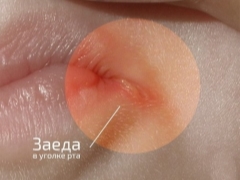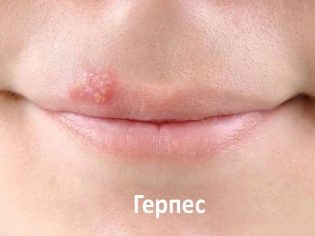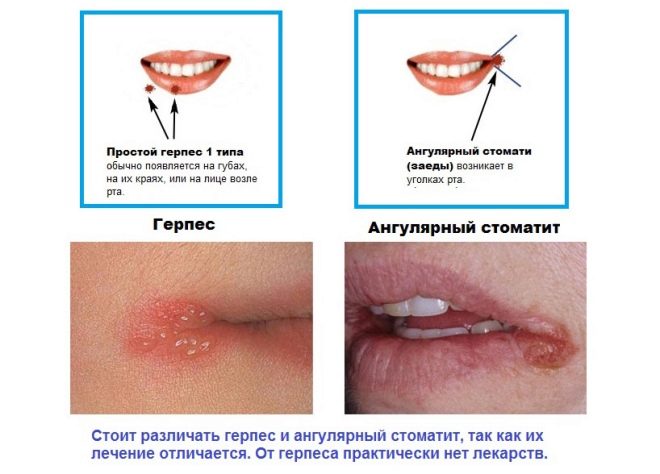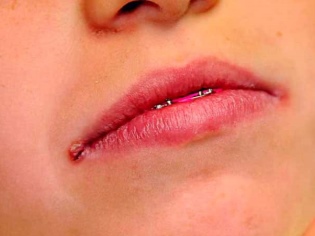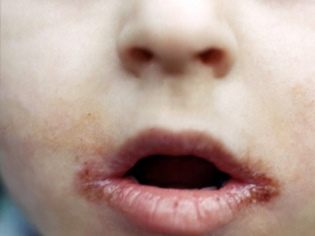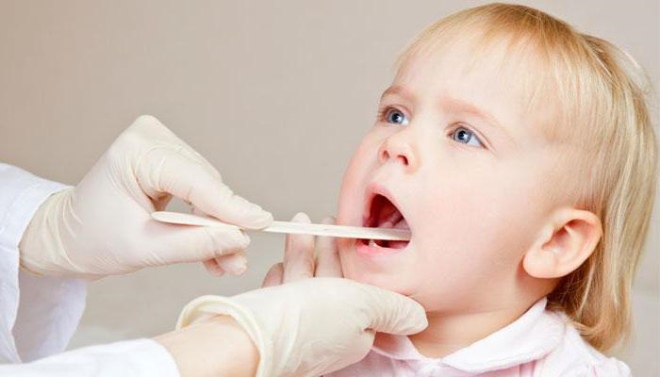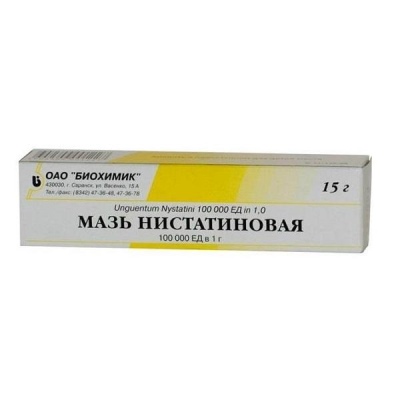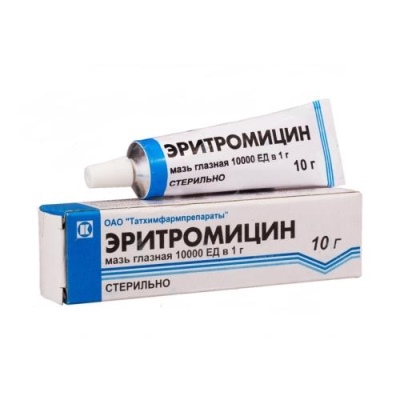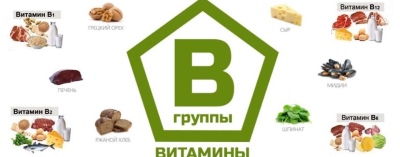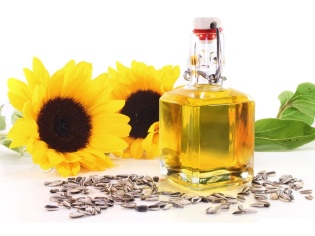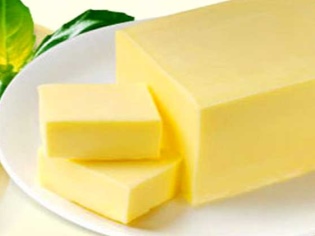Angulite in the corners of the mouth in children
Bloody or whitish cracks in the corners of the child’s mouth are a symptom of a fairly common disease that many have encountered, but not many know what it really is. About why angulite develops and how to treat it, you will learn from this article.
What it is
Angulite has a clearer popular name - “Zade”. This inflammatory process, which affects the mucous membranes and corners of the mouth, has other names - angular stomatitis and angular cheilitis.
In case of illness, the child has a characteristic lesion located in the corner of the mouth. It can be quite large and bleeding or almost invisible.
The most common angulite appears in the spring, when there are not enough vitamins, and the child’s immunity after the cold season and past diseases is reduced. Very often, parents are confused to pick up with herpes simplex, which may also appear on the lips.
There is a difference - with herpes a watery rash appears, which then merges into a crust, and with angulitis, eczema does not go through the rash stage, and is localized strictly in the corners of the lips. Whereas a herpetic infection can affect any part of the nasolabial triangle.
The reasons
Causes of lesions in the corners of the mouth are streptococci.. These germs, multiplying, and create painful cracks and crusts that cause discomfort and spoil the appearance of the child. Such angulitis is called streptococcal. Streptococci are widespread microbes, and it is not difficult to carry them into a small microcrack in the skin.
In second place among the causes of zaedu - fungi-candida. They also live almost everywhere and infection is more than likely. This type of disease is called yeast or candidomycotic zaedoy. Microcracks and a favorable environment for these pathogens are usually formed against the background of a deficiency in the body of vitamin B2 (riboflavin), diabetes. And for the fungal form, the most likely preceding factor is long-term treatment of the child with antibiotics, corticosteroids and drugs - cytostatics.
Why a crack is formed, medicine can explain only with great stretch. Most often, this process is associated with skin folds, which are formed in the corners of the mouth with a decreasing bite. And infection cracks most often occurs when non-compliance with the rules of hygiene.
Symptoms
Streptococcal zadea proceeds slightly differently than the fungal. Attentive parents will be able not only to determine the signs of angulitis, but also to establish which pathogen caused the inflammatory process.
When the yeast form of the disease in a child in the corner of the mouth, lacquer red erosion is formed. Quite often they are covered with a whitish or grayish bloom. This film can be easily removed if desired. Crust on the surface of erosion is not formed. And in general, she leads a rather “modest lifestyle,” most of the time masking herself in a skin fold in the corner of her lips.
It is possible to consider fungal angulite only when the child’s mouth is open. Very often, this inflammation is chronic - it appears and then disappears. Remissions can be quite long, exacerbations occur with any decrease in immunity, ARVI, flu, colds and other ailments and conditions.
Streptococcal angulitis begins with the fact that a bubble with a thin top layer appears in the corner of the lips. It bursts quickly and leaves a slit-shaped erosion. It is quite deep. In a matter of hours, erosion becomes covered with a purulent-bloody crust. If this crust is removed, bloody erosion is again formed under it with a noticeable crack in the very center. A child with such zaedy feels moderate unpleasant "stinging" and burning at the moment when he opens his mouth.
Diagnosis of the disease is based only on these symptoms. To confirm, the doctor makes scrapings from the erosion coating to find out who lives there - candida fungi or streptococci. This is crucial for effective and fast treatment.
Additional diagnostics
If you go to a doctor with an angulite, then you should not be surprised that the doctor will prescribe a child for tests that exclude the presence of congenital or acquired syphilis.
The fact is that eczema with angular stomatitis is very similar to similar formations around the mouth in syphilis, differing only in the density of formations. It is for this reason that additional tests for syphilis should not embarrass and resent moms and dads.
A thoughtful pediatrician will also give direction to a biochemical blood test, which will allow you to see if your child has a pronounced deficiency of vitamins, in particular vitamin B.
Treatment
The most common in children is the bacterial (streptococcal) form of angulitis. But yeast is also not considered an exceptional phenomenon. Treatment with these forms of bunks will differ in the main direction of therapy. In the first case, it will be necessary to destroy the bacterium and prevent further infection, and in the second, antifungal treatment is prescribed, since antibiotics are mostly effective against fungi.
Yeast Angulite
The most popular drug with this zaeda - "Fukortsin". This is a saturated raspberry solution, which is also called Castellani solution. The drug has a pronounced antiseptic and antifungal effects. They are recommended to smear the lesion site 2-3 times a day, and the rest of the space around the mouth is wiped with any antiseptic agent in order to avoid the spread of fungal colonies.
«Fukortsin»Used as part of complex treatment with one of the antifungal ointments. Most often, children are prescribed “Nystatin ointment” or “Levorin ointment”. "Sulfur and salicylic ointment" (in a 2% concentration of the active substance) has a good efficacy in the fungal infection of the skin. At the same time with local treatments, the intake of vitamins of group B is prescribed. Riboflavin (B2) and nicotinic acid (PP) act in the best way.
If angulite is not in a hurry to give in to such therapy, and the jam does not decrease, the doctor may recommend that the child take "Fluconazole". This systemic antifungal drug is given in individual dosage, which depends on the age and weight of the child. The average dose is calculated from the formula “6 mg of the drug per kilogram of body weight” on the first day of treatment, and then only 3 mg of the drug is multiplied for each kilogram. Fluconazole is given to breastfeeds once every three days, and the rest - once a day.
On average, the treatment of yeast bunks takes about 10-14 days. After recovery, the course should continue for about 7-10 days to achieve a stable result, since fungal infections tend to return even with the minimum number of microorganisms that survived the first course of treatment.
Streptococcal Angulite
To combat streptococcus that settled in the corners of the lips, local antiseptics, which are alcohol solutions of aniline dyes, for example, brilliant green solution (brilliant green), are most often used.Of course, the child will look somewhat frightening, but not for long - streptococcal infections are easier to treat than fungal infections. In combination with green paint prescribed ointment with antibiotics. Usually in pediatric practice use "Erythromycin ointment" or "Syntomycin ointment".
The use of Vishnevsky ointment for the treatment of zaed was considered effective not so long ago. Now medicine looks critically at therapy with the use of this remedy - Vishnevsky ointment is quite toxic and is not suitable for use on mucous membranes.
This medication does not usually require systemic antibiotics (pills, syrups, injections), the local action of antibacterial drugs is enough for a full cure in 7-10 days. By analogy with yeast angulite, with the bacterial form of the disease, vitamin preparations are also prescribed that contain vitamins A, E, C, PP and B2 in sufficiently large quantities.
Nutrition during treatment
Therapy will be more effective if the child follows a certain diet.
In the diet of a kid with angulite, you must add foods rich in vitamin B (liver, cabbage, apples, dairy products, egg yolk, poultry, sea fish). From the nuts, in which the desired vitamin is most contained, it is better to refuse, because the nuts themselves can cause quite a strong allergy.
At the time of treatment, as well as during the recovery period (about a month), spicy and salty dishes, fried foods, food with spices and food dyes should be excluded from the kid’s menu. These products further irritate and injure the affected mucous in the corners of the mouth. In the treatment of fungal angulitis, it is better to refrain from taking yeast and baking from yeast dough.
Folk remedies
Not all folk remedies, the recipes of which can be found in large quantities on the Internet, are equally good and useful when you cheat a child. So, the recommendations to lubricate the corners of the lips with sunflower, butter, seem rather dubious. Indeed, in a warm and oily environment, bacteria and fungi do not die.
Official medicine more favorably looks at the use of sea buckthorn oil for lubricating a dry crust in a bacterial disease. Sea buckthorn oil has a certain antimicrobial effect. However, this does not negate the main treatment, which should include antibiotics and antiseptics. Another important condition is that sea buckthorn oil can be used not in the acute stage of the angulite, but already at the recovery stage.
Strong green tea, aloe juice is often used as natural antiseptics.
Prevention
- For prophylaxis It is important to ensure that the child does not bite, does not chapped the lips. To do this, you can teach your child to use petroleum jelly or special hygienic lipstick for children.
- Follow the mouth - Undertreated or generally untreated caries many times increases the likelihood of contracting streptococcal form of angulitis.
- You should spare no effort and time to strengthen children's immunity.. Against the background of immunodeficiency, angular stomatitis occurs much more frequently. To strengthen the child’s immune protection, it is necessary to feed properly and in a balanced way, make sure that he has enough vitamins and trace elements, harden him, take him to the sports section and walk with him fresh air as often as possible.
The doctor-dermatologist G.V. will tell about what you need to know about child bristles. Menshchikov in the next video.
